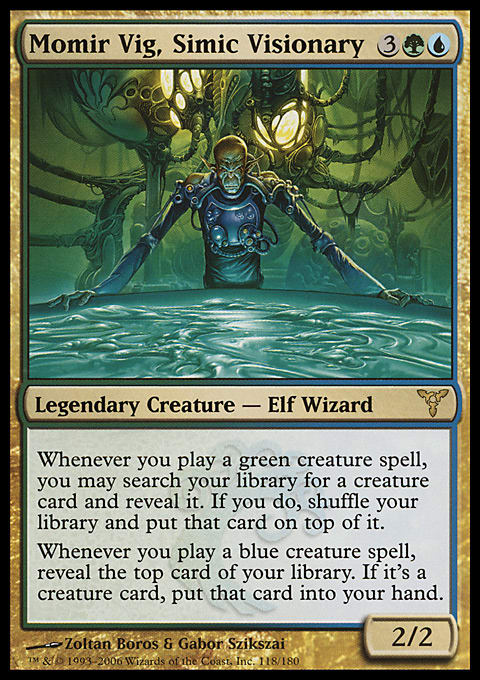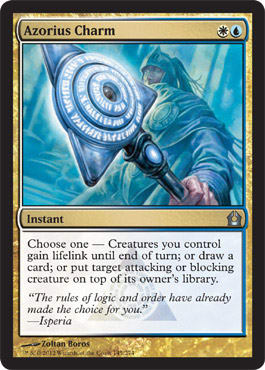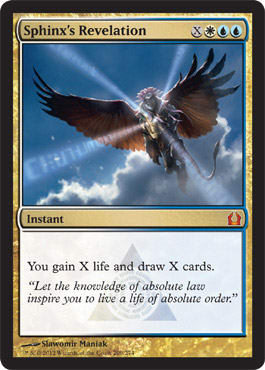By the time you read this article, chances are pretty good the results of Pro Tour Gatecrash have been scrutinized, analyzed, sliced, diced, and pureed by eighty-seven different writers all offering their takes on what the tournament’s results mean for the future of Standard. It’s something of a ritual in the Magic writing community, one that serves to help us all to collectively digest What We Just Saw and move on to What Comes Next.
So you don’t need to read about my opinion on Standard (too few Duskmantle Seers). I (rightfully) leave that sort of analysis and talk to the people in the weeds, the Patrick Chapins and Gerry Thompsons, who have earned the right to discuss the “what” of this historical Pro Tour.
Instead, I want to talk about the “how” of Pro Tour coverage and give you a bit of a look behind the scenes of the production of a Pro Tour from the perspective of me, your handy, everyday text coverage reporter.
It Takes a Village
But first, a short story: After the first day of Pro Tour Gatecrash, several other coverage folk and I—including Brian David-Marshall and the Walking the Planes crew, among others—were unwinding in the hotel lobby playing a few games of Commander. (There’s little that coverage reporters love more than unwinding from a day of covering Magic by spending the evening playing Magic.)
While we were down there, a quartet of guys came up to us filled with questions. They were casual players who mostly stuck to Friday Night Magic and were not only curious what format we were playing and what cool spells we were slinging, but why in the world the Brian David-Marshall was in the same hotel they were in. And, holy crap, that’s Marshall Sutcliffe as well! And the guy from Walking the Planes! And—well, they had no idea who I was.
So, the four sat down and talked with Brian about how much they enjoy his videos while asking why we were all in Montreal. They didn’t actually know the Pro Tour existed, but they were excited to hear all about it and share their own stories with the Brian David-Marshall. They sat with us for a while, asked Brian a ton of questions, and used the word “awesome” probably a hundred fifty-four times or so before taking off.
I tell this story to illustrate a few points. First of all, yes, BDM, Marshall, Nate (from Walking the Planes), Rich Hagon, and everyone else you see in coverage are just as awesome as they appear on your computer. They’re all huge fans of the game, who, after a day spent talking about Magic, watching Magic, and analyzing Magic, really enjoy being around more Magic when the cameras turn off. What you see on screen is exactly what you get with this crew, and that’s why I always look forward to working with them every chance I have.
The second point is that “the talent” (and, no, I’m not counting myself in that category, even if I am recognized now and then as the guy on the laptop in the background) is actually just part of a much larger crew that makes all of this happen.
Check this out:

This is just a fraction of the people who make video happen.
This is just a small selection of the people who work to beam you moving pictures of Magic cards. The production scales down for Grands Prix significantly, but it’s not as simple as sticking a camera above the play space and turning it on. Our video crews spend hours just doing prep work, and on days when we writers have a late call (we typically arrive about an hour before the players do), video will get there an hour or even two before we do.
There’s a ton of time spent on production value, and based on people’s responses, the audience seems to appreciate it. By several metrics, this was one of, if not the, most successful Pro Tours from a coverage perspective. More and more of you/us are consuming Magic coverage than ever before—both in written and video form.
Third, it’s important to keep in mind that coverage is aimed at a number of different audiences, meaning every piece may not be aimed at your particular demographic. If you’ve been playing Magic for upward of forever, chances are we’re going to over-explain things both on video and text. That means that some of the most natural phrases in the world to us and other longtime players—milling, shocking, cycling, and so on—are things we sometimes strive to avoid casually tossing out. So when you read or hear us saying or writing something like, “He chose to draw a card with Azorius Charm,” instead of, “He cycled Azorius Charm,” that’s the reason.
Day 1
Day 1 of a Pro Tour sets the tone for the entire weekend. Typically, the day before the start of Day 1, we hold an all-coverage meeting to discuss the potential story lines and pieces we’d like to pursue. At this point, we bat around a ton of ideas, most of which we’ll never have time to write or produce.
But that doesn’t mean we don’t cover them in some fashion. Between video, Twitter, CoveritLive, Facebook, and written coverage, someone often picks up an idea and runs with it. For example, we talked prior to the tournament about the effect of Gatecrash lands on mana bases, but we weren’t able to find time to do a full written piece. But video took up that string and peppered it throughout their discussion throughout the tournament.
Likewise, the story I wrote called “Friends, Grecians, Countrymen” came to me from Brian David-Marshall, who had found out that all four players from Greece and Cyprus were on their first Pro Tour and that three had made Day 2. As we headed toward the Top 8, video had to cover the race to the top and couldn’t take time out for a feature story like this, cool as it might be. So instead, they pitched it to me, and I ran with it. That kind of back and forth means we’re never short ideas.
Now, there’s not much I can comment on for production of video, as I only get to sort of tangentially see how that happens. But one thing I can talk about is the new cards-in-hand tool. This was the coolest new addition to coverage, and reactions seemed to be pretty positive. As one of the spotters, I can tell you first hand that keeping track of hands in a format with Sphinx's Revelation—where a hand can change by seven cards in an instant—can be difficult. But the result is worth it. This was the first time we’ve used this tool, and though improvements in the process can be made, I’d call the first iteration a success overall.
On the written side, our process involves a lot of behind-the-scenes work as well, though not nearly as much as video. We writers research and write our stories, hand them off to an editor, who then hands them off to a producer, who puts them on the web. Some articles involve some collaboration between writers, and those will be passed back and forth between them until finished.

The writer’s table at PT: Gatecrash. Not shown: Any of the writers. We’re all of chasing stories, or in my case, taking this picture.
Now, I’ve been a journalist for much of my professional career. I’ve written on deadlines that were seemingly impossible, and as an editor, I’ve set deadlines that were seemingly impossible. I’ve rushed to break stories before anyone else, and I’ve submitted city council stories before the city council meeting was over. And yet, nothing compares to the rush of writing for a Magic tournament.
Think about it. In the span of about a round, we have to research and write a full article. Things are a bit easier than full-on news articles because all of our sources are right there and we’re already experts on the topic (Magic). However, we also have to deal with source availability—most of them are actually busy playing, after all—and other responsibilities, such as helping out with the Draft viewer or the cards in hand tool. Grands Prix can be even tougher with more rounds each day and fewer breaks to catch your breath.
And I love it. Other journalists will know why, but for the rest of you, just know that, when you finally catch your breath at the end of the day, you feel a pretty strong sense of accomplishment. We tend to feel pretty good about ourselves at that point.

“Hey, everyone, come see how awesome I look,” is what Rashad Miller was totally probably maybe thinking at this point.
And when the day is over, typically about an hour or two after players have left, though Day 1 is usually on the lower end, our desks often look like this:

Not pictured: The other seven cans of caffeine I consumed during the day.
Exhausted, we typically grab some food, retire to the hotel, and . . . play more Magic.
Day 2
Day 2 is much the same as Day 1. We arrive about an hour before the players do and plan out our day, chase down stories, and cover feature matches as necessary.
And as we’re all fans of the game, now and then, you can spot this in a rare quiet moment:

Coverage reporters like watching coverage, too.
And that brings me to another important part of coverage. As we run around interviewing, collecting stories, and writing articles, we often can feel that we’re missing the bigger picture. We make a point to stop every now and then and just walk the tournament or watch feature match coverage to make sure we don’t lose sight of what’s happening. Usually, we can only pull this off if we finish a story early or if we’re waiting for the next round to start, but it’s invaluable to take time to actually get the bigger picture.
I like to think of the individual stories we do as snapshots of the tournament. I can write a feature match and give you an in-depth look at that particular match, but it’s a relatively small part of the tournament. But when you combine all of those snapshots, the goal is to give you a vivid, 3-D rendering of the tournament, as it were, from the combination of all of those bits and pieces. Hopefully, you can absorb as much or as little coverage as you like in order to form as clear a picture as you want, and between articles, videos, tweets, and CoveritLive, you might actually just feel as though you’re there.
Day 2 usually goes a bit later than Day 1, if for no other reason than we’re often typing up decklists and Top 8 profiles, winding down the last few features, and generally preparing for the Top 8. There’s less to do overall for the Top 8—no more feature articles and almost no analysis articles—but the stage is bigger, the stakes are higher, and everyone is more than just a big excited.
Day 3

Here’s the Top 8 feature match area before the action starts.
Top 8s are always tricky for doing feature match coverage. You have seven articles to write over the course of a few hours while matches overlap, and we’re on a clock that isn’t as predictable as Swiss rounds.
In the Swiss, once you finish a match, you can look at the round clock and figure out how much time you have to finish your piece. For the Top 8, it’s a bit different. In a Grand Prix, as soon as a round is done, we dive right into the next one. That often means one reporter covering multiple matches, or, sometimes astoundingly, finishing one piece while covering another match. The degree of difficulty is pretty high.
Like Days 1 and 2, video and text coverage often talk back and forth about what they’ve discovered. Rich Hagon, for example, came to me before the tournament and talked about how most pros he spoke with thought that matches would shake out. He confirmed what I had heard from a few others (Patrick Chapin, for example), that Tom Martell was universally considered an underdog against Melissa DeTora. As a result of that conversation, I came up with the storyline for that feature match, one I was particularly happy with. The quote at the top of the story from Martell was actually said to Nate Price. We collaborate, and it makes everyone all the more knowledgeable.
Likewise, Tim Willoughby came to me before the Top 8 video started to make sure we were on the same page for what we were calling decks, since I had written the metagame breakdown on Day 1 after Nate Price and Josh Bennett had assembled most of the data. In that way, we try not to confuse people by referencing the same thing differently between text and video.
From there on, it’s show time till we crown a champion. I was fortunate enough to write a match each round of the Top 8 and even more fortunate to cover the eventual champion each and every round. It was the first time I’d ever covered the finals of a Pro Tour (though I did cover the finals of the World Magic Cup), and it was incredibly cool.

Tom Martell and Jon Finkel’s scarf won Pro Tour Gatecrash with Sam Black’s deck.
Not that there was time to enjoy it too much. Our readers demand content. And by content, I mean decklists. So for the next few hours, we feverishly type in all of the decks that hit at least 18 points in Standard. There are a lot. And by this time, our fingers are so numb and brains so addled from the weekend that we start cracking jokes about typos as we fix them, laughing uproariously at even mildly funny typos like “Overgrown Tom.”
So by the end of the weekend, we’re exhausted, rundown, and have been talking or writing about Magic for virtually three days straight. I personally had to catch a plane at 6:00 A.M. the next morning to return to my day job (which doesn’t involve Magic but does involve writing). Clearly, there’s only one thing on our mind for the rest of the evening.
Drafts.
























